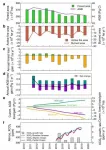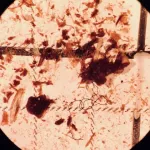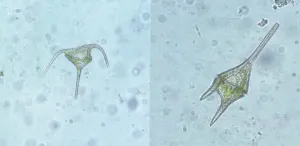An OU-led study sheds new insight on forest loss and degradation in Brazilian Amazon
2021-04-29
(Press-News.org) An international team led by Xiangming Xiao, George Lynn Cross Research Professor in the Department of Microbiology and Plant Biology, University of Oklahoma College of Arts and Sciences, published a paper in the April issue of the journal Nature Climate Change that has major implications on forest policies, conservation and management practices in the Brazilian Amazon. Xiao also is director of OU's Center for Earth Observation and Modeling. Yuanwei Qin, a research scientist at the Center for Earth Observation and Modeling, is the lead author of the study.
For the study described in the paper, "Carbon loss from forest degradation exceeds that from deforestation in the Brazilian Amazon," Xiao, Qin and a team of research scientists and faculty from institutes and universities in the United States, France, the United Kingdom, Denmark and China used satellite data to track spatial-temporal changes of forest area and aboveground biomass in the Brazilian Amazon from 2010 to 2019. They discovered that carbon loss from forest degradation was greater than that resulting from deforestation in the region, which indicates forest degradation should become a high priority in policies, conservation and management.
Tropical forests in the Amazon account, Qin notes, for approximately 50% of the rainforests in the world and are important for global biodiversity, hydrology, climate and the carbon cycle. Accurate and timely data on vegetation aboveground biomass and forest area in the region at various spatial and temporal scales are also essential for data-based policies and decision making. This international team harnessed diverse data for monitoring, reporting and verification of tropical forests. The paper published in Nature Climate Change is a follow-up of a previous study published in Nature Sustainability in 2019, which reported improved estimates of forest areas in the Brazilian Amazon.
INFORMATION:
[Attachments] See images for this press release:

ELSE PRESS RELEASES FROM THIS DATE:
2021-04-29
As part of a laboratory experiment, Rebecca Holmes examined water bottles that had been acquired from abroad expecting to find bisphenol A (BPA), a human-made component commonly found in polycarbonate plastics used to make consumer products.
What she found, however, was that those water bottles were just fine, yet some control bottles purchased in the United States and supposedly BPA-free actually contained traces of the chemical now thought to negatively impact heart health.
Holmes, a researcher formerly in the laboratory of Hong-Sheng Wang, PhD, professor in the University of Cincinnati Department of Pharmacology and Systems Physiology, was working on her master's degree in molecular, cellular and biochemical ...
2021-04-29
WASHINGTON, D.C. (APRIL 29, 2021) - Results from a new study find a broad range of patients who typically undergo revascularization for stable ischemic heart disease (SIHD) in the U.S. did not meet enrollment criteria for the ISCHEMIA trial. The data, which was presented today as late-breaking clinical science at the Society for Cardiovascular Angiography & Interventions (SCAI) 2021 Scientific Sessions, demonstrates a minority of SIHD patients referred for coronary intervention in contemporary practice clearly resemble those enrolled in the ISCHEMIA trial.
Ischemic heart disease impacts more than 13 million people in the United States and is the leading cause ...
2021-04-29
WASHINGTON, D.C, (April 29, 2021) - An analysis of growth patterns in transcatheter aortic valve replacement (TAVR) programs across United States hospitals is being presented as late-breaking clinical science at the Society for Cardiovascular Angiography& Interventions (SCAI) 2021 Scientific Sessions. The findings indicate that TAVR hospital programs are predominately located in metropolitan areas serving patients with higher socioeconomic status, potentially contributing to the disparities in cardiac care.
TAVR is a minimally invasive procedure for patients in need of a valve repair or replacement and is an alternative to surgical aortic valve replacement (SAVR), a treatment ...
2021-04-29
Washington, D.C., April 29, 2021 - Two studies related to percutaneous coronary intervention (PCI) evaluating the use of risk-avoidance strategies and robotic-assisted technology, respectively, are being presented as late-breaking clinical science at the Society for Cardiovascular Angiography & Interventions (SCAI) 2021 Scientific Sessions. An analysis of strategically avoiding high-risk PCI cases indicates systematic risk-avoidance does not improve, and may worsen, the quality of hospital PCI programs. A study of a robotic-assisted PCI shows the technology is safe and effective for the treatment of both simple and complex lesions; this has the potential to address the occupational ...
2021-04-29
The United Kingdom government plans to implement mass scale population testing for SARS-CoV-2 infection using Lateral Flow Devices (LFDs), yet the devices' sensitivity is unknown. A study published in the open access journal PLOS Biology by Alan McNally at University of Birmingham, UK, and colleagues suggests while LFDs are highly effective in identifying SARS-CoV-2 in individuals with high quantities of viral RNA present on the test swab, they are inaccurate at diagnosing infections in individuals with lower viral loads.
LFDs are increasingly used to increase testing capacity and screen asymptomatic populations for SARS-CoV-2 infection in mass surveillance programs, yet there are few data ...
2021-04-29
Forget diamonds--plastic is forever. It takes decades, or even centuries, for plastic to break down, and nearly every piece of plastic ever made still exists in some form today. We've known for a while that big pieces of plastic can harm wildlife--think of seabirds stuck in plastic six-pack rings--but in more recent years, scientists have discovered microscopic bits of plastic in the water, soil, and even the atmosphere. To learn how these microplastics have built up over the past century, researchers examined the guts of freshwater fish preserved in museum collections; they found that fish have been swallowing microplastics since the 1950s and that the concentration of microplastics in their guts ...
2021-04-29
NASA's Hubble Space Telescope is giving astronomers a rare look at a Jupiter-sized, still-forming planet that is feeding off material surrounding a young star.
"We just don't know very much about how giant planets grow," said Brendan Bowler of the University of Texas at Austin. "This planetary system gives us the first opportunity to witness material falling onto a planet. Our results open up a new area for this research."
Though over 4,000 exoplanets have been cataloged so far, only about 15 have been directly imaged to date by telescopes. And the planets are so far away and small, they are simply dots in the best photos. The team's fresh technique for using Hubble to directly image this planet paves a new route for further exoplanet ...
2021-04-29
Boulder, Colo., USA: Thirty-one new articles were published online ahead of
print for Geology in April. Topics include shocked zircon from the
Chicxulub impact crater; the Holocene Sonoran Desert; the architecture of
the Congo Basin; the southern Death Valley fault; missing water from the
Qiangtang Basin; sulfide inclusions in diamonds; how Himalayan collision
stems from subduction; ghost dune hollows; and the history of the Larsen C Ice Shelf. These Geology articles are online at END ...
2021-04-29
The genome of single-celled plankton, known as dinoflagellates, is organized in an incredibly strange and unusual way, according to new research. The findings lay the groundwork for further investigation into these important marine organisms and dramatically expand our picture of what a eukaryotic genome can look like.
Researchers from KAUST, the U.S. and Germany have investigated the genomic organization of the coral-symbiont dinoflagellate Symbiodinium microadriaticum. The S. microadriaticum genome had already been sequenced and assembled into segments known as scaffolds but lacked a chromosome-level assembly.
The team used a technique known as Hi-C to detect ...
2021-04-29
DURHAM, N.C. - Mantis shrimp don't need baby food. They start their life as ferocious predators who know how to throw a lethal punch.
A new study appearing April 29 in the Journal of Experimental Biology shows that larvae of the Philippine mantis shrimp (Gonodactylaceus falcatus) already display the ultra-fast movements for which these animals are known, even when they are smaller than a short grain of rice.
Their ultra-fast punching appendages measure less than 1 mm, and develop right when the larva exhausts its yolk reserves, moves away from its nest and out into the big wide sea. It immediately begins preying on organisms smaller than a grain of sand.
Although they accelerate their arms almost 100 times faster than a Formula One car, Philippine mantis shrimp larvae are slower ...
LAST 30 PRESS RELEASES:
[Press-News.org] An OU-led study sheds new insight on forest loss and degradation in Brazilian Amazon





